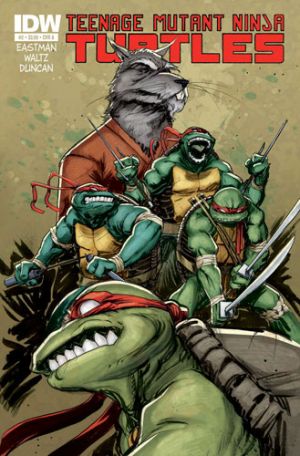Comics /
Comic Reviews /
More Comics
Teenage Mutant Ninja Turtles #2
By Zak Edwards
September 21, 2011 - 18:05
I, like many of my generation, grew up on a sometimes healthy, sometimes unhealthy diet of Teenage Mutant Ninja Turtles. They were on my television, in my drawer of action figures, used to fight countless foot soldiers in video games, and reenacted in my playtime with friends. For me though, they were never in my reading material, something that I’m sure I share with plenty of people my age. Some may not even know the Turtles came from comics, I certainly didn’t for an embarrassingly long time, and even if I did, the collections of the original material are often quite expensive/ rare/ not very comprehensive. So the beginning of a new TMNT ongoing with the creative input of the original creators got me very excited, and after the first issue I was even more so. The book appears to start things off fresh, a brand new start, and certainly doesn’t look or feel like anything my limited childhood experience can muster up. No, this is TMNT done with a specific audience in mind and it just so happens they’re talking to my generation.
 |
All of the familiarities are here: the ninjas, the turtles and their basic personalities (making them easily distinguishable even when they all wear red), Splinter as old man mentor, and the strange blend of science and mysticism that I recognized from past encounters. Everything is simultaneously immediately recognizable and new, making the book fun and engaging on multiple levels. Of course the first is comparison to prior knowledge, always the initial reaction with reboots, but the story in itself is well constructed. Taking place both in the present and fifteen months in the past, when the Turtles were created, writers Kevin Eastman and Tom Waltz have three stories running simultaneously, none of which feel left out or unimportant. The pacing and balance in the stories is a feat in itself, making the audience care and be invested in each story for its own reasons. Firstly there is the origin story in which scientist April O’Neil, sans her trademark yellow suit, is working for a scientific company responsible for the Turtles and their sensei. The story feels necessary despite being very telegraphed, with the presence of ninja fight sequences certainly aiding in the entertainment end of things. There are plenty of mysteries to be had in the flashbacks as well: like why the ninjas are there in the first place and what is going on in the pre-mutated but super smart Splinter’s head. April herself is painted in fairly large strokes, but she is still a capable protagonist in her own story and even somewhat holds her own against a couple of ninjas. The second story of the Turtles and their quest against Old Hob, a mutated cat with a penchant for gang violence, and searching for their lost brother Raphael, who can be found in the third story. The choice to write the origin story as a flashback is a good idea for aiming the book at people already familiar with the Turtles, making sure their favourite characters are around in a familiar form right from the get-go. Even though the Turtles mostly stand around in this issue and their total time takes up two pages, their characteristics make them a lot of fun to see again. Each occupies their role: Leonardo is the serious minded leader, Donatello the scientist in word and deed, Michelangelo the pizza-eating, lovable comic relief, and give some direction to the present-day stories, a necessary breather to outline some of the goals of the book. Finally, Raphael’s story of being a homeless person with a heart of gold may have some of the most stereotypical and predictable constructions, but it is still entertaining. The fact he saved Casey Jones from an abusive alcoholic father is fairly obvious, but the very fact the scenario exists in a TMNT comic had me very intrigued. Once again, the slightly older and already familiar demographic is obviously being targeted, but in a way different from the movie a few years ago. The book is not a kid’s book looking to rope in an older audience as well, but rather the opposite. It’s quite refreshing actually, and I appreciate Eastman and Waltz’s approach. Overall, the balance, pacing, and tone keep things fresh and exciting, certainly enough for me to care where this book goes.
The more I look at Dan Duncan’s art, the more I like it. I wish I could say the interior looks like his exterior, but it doesn’t. The production value is less and the covers are so far incredible, matching that quality would be near impossible. The interiors, by contrast to his covers, are more stripped down and basic, an aesthetic I needed to warm up to. His facial expressions, and the inked lines one the human characters in particular, aren’t very expressive, but his panelling and action sequences are wonderful. By keeping the backgrounds fairly basic, Duncan focuses attention on the foreground, where his energy looks the best. His construction of panels, both together and individually, is communicative and equally energetic. In particular, the page where the Turtles and Splinter are first seen in the ooze, the page just looks professional and well thought out. Where each subject is and everything is just plain cool to look at. So while it could be improved in some places, particularly the humans, Duncan’s art looks pretty good for everything else.
Grade: B+ The stories are engaging and the art works well, exactly what’s needed for a great, well-targeted reboot.
Last Updated: January 17, 2025 - 08:20
